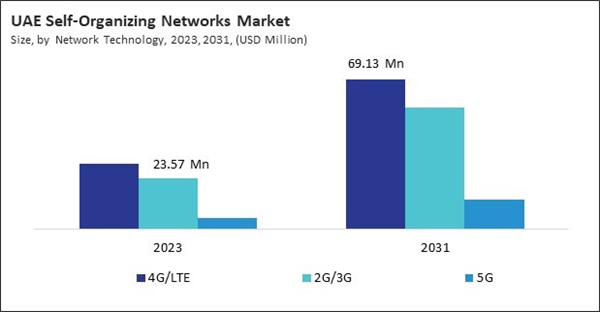The Brazil market dominated the LAMEA Self-Organizing Networks Market by country in 2023, and is expected to continue to be a dominant market till 2031; thereby, achieving a market value of $299.8 million by 2031. The Argentina market is registering a CAGR of 14.1% during 2024-2031. Additionally, the UAE market would witness a CAGR of 11.6% during 2024-2031.
Users expect uninterrupted and high-quality connectivity, so SON enables service providers to proactively address potential issues and improve user satisfaction. Governments and regulatory bodies worldwide are encouraging the adoption of advanced networking solutions like SON to support digital transformation and connectivity goals.
SON is used for various purposes, making it a cornerstone of modern networking. Automating the setup of new network components, including base stations and access points, significantly accelerates deployment and reduces errors. SON systems can identify network issues in real time and implement corrective actions autonomously, minimizing downtime.
By dynamically adjusting network resources based on demand, SON reduces energy consumption, contributing to sustainable operations. SON ensures optimal traffic flow by rerouting data during peak times or when certain network components are underperforming. Predictive analytics in SON helps operators anticipate demand and plan capacity upgrades proactively.
The UAE’s commitment to smart city development and artificial intelligence through initiatives like the Smart Cities & Artificial Intelligence Plan (2018-2022) and the National Artificial Intelligence Strategy 2031 underscores its focus on leveraging advanced technologies for infrastructure and mobility management. Self-organizing networks play a critical role in smart cities by enabling automated network management for IoT devices, ensuring uninterrupted connectivity, and reducing operational costs. With the UAE’s emphasis on integrating AI into national development, SON solutions will likely see accelerated adoption to support AI-driven infrastructure and smart mobility systems, aligning with the country’s vision to lead AI innovation by 2031. In conclusion, the dynamic advancements in 5G infrastructure in Saudi Arabia and the UAE’s focus on smart cities and AI integration are driving market growth in the region.
List of Key Companies Profiled
- Qualcomm Incorporated (Qualcomm Technologies, Inc.)
- Ericsson AB
- ZTE Corporation
- Nokia Corporation
- Rohde & Schwarz GmbH & Co. KG
- Siemens AG
- Cisco Systems, Inc.
- Huawei Technologies Co., Ltd. (Huawei Investment & Holding Co., Ltd.)
- Amdocs Limited
- CommScope Holding Company, Inc.
Market Report Segmentation
By Offering
- Software
- Services
By Architecture
- Centralized Self-Organizing Networks
- Distributed Self-Organizing Networks
- Hybrid Self-Organizing Networks
By Network Technology
- 4G/LTE
- 2G/3G
- 5G
By Network Infrastructure
- Radio Access Network
- Core Network
- Backhaul
- Other Network Infrastructure
By Application
- Network Security & Authentication
- Intermachine Communication
- Gaming
- Global Positioning System
- WAP
- Other Application
By Country
- Brazil
- Argentina
- UAE
- Saudi Arabia
- South Africa
- Nigeria
- Rest of LAMEA
Table of Contents
Companies Mentioned
- Qualcomm Incorporated (Qualcomm Technologies, Inc.)
- Ericsson AB
- ZTE Corporation
- Nokia Corporation
- Rohde & Schwarz GmbH & Co. KG
- Siemens AG
- Cisco Systems, Inc.
- Huawei Technologies Co., Ltd. (Huawei Investment & Holding Co., Ltd.)
- Amdocs Limited
- CommScope Holding Company, Inc.
Methodology

LOADING...









